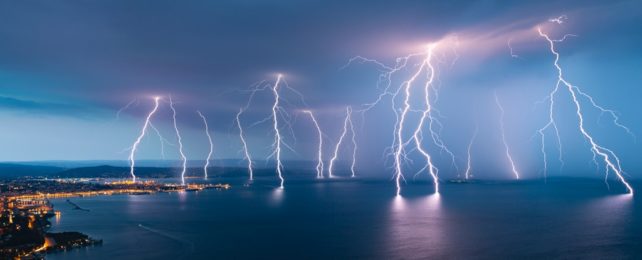Half a century ago, the American mathematician Edward Lorentz famously inquired whether a butterfly flapping its wings in Brazil might, through a chaotic domino effect, set off a tornado in Texas.
If he'd instead asked whether enough locusts flapping their wings could charge the air with the potency of a thunderstorm, the question might have become equally famous. He didn't, but now we have an answer.
A new study on the influence flying insects can have over atmospheric electric fields has found the flapping of a multitude of tiny wings can electrify the air much the same way swirling clouds of water vapor can charge the air inside a storm.
While this doesn't mean we have to be concerned by biblical plagues of lightning-shooting locusts, it could be evidence of a need to take biological phenomena into account when modelling localized patterns in the atmospheric electric field.
Zoom in close to the atoms making up dust, moisture, and insect body parts zipping about in the air above, and you'll find electrons being jostled like loose change in a runner's pocket.
Given enough jostling, those negatively-charged particles can spill from their positively-charged pockets, creating a difference called a potential gradient.
In a storm, small ice particles rising on columns of air can rub against larger fragments tumbling towards the ground, generating a conveyer belt of charges that exaggerate potential gradients between cloud tops, cloud bottoms, and the ground below.
While the build-up of charge is essentially invisible, the effects aren't. Once the gradient reaches a tipping point, ionized channels form and the balance is effectively evened out in a rush we see as lightning.
Even in the absence of lightning, zones of contrasting charges can exert influence over the movements of ions, including various pollutants and dust particles.
A variety of factors can determine the magnitude and positioning of potential gradients, from cloud movements to precipitation, to even showers of cosmic rays, but until now nobody had really considered the impact of biological phenomena.
"We always looked at how physics influenced biology, but at some point, we realized that biology might also be influencing physics," says the study's first author Ellard Hunting, a biologist at the University of Bristol in the UK.
"We're interested in how different organisms use the static electric fields that are virtually everywhere in the environment."
It's become clear in recent years that insects and other invertebrates can carry charges that give themselves a tiny potential against the surrounding atmosphere. Baby spiders might even use this trick to launch themselves into the sky.
But how this itty-bitty potential aggregates in swarms has never been measured. So Hunting and his team ventured out to a University of Bristol School of Veterinary Sciences field station to await the swarming of one of their many honeybee colonies.
Using an electric field monitor and a camera to monitor the bees' density, the researchers tracked the local potential gradient of a swarm in transit. For 3 minutes the insects zipped past, raising the potential gradient overhead by up to 100 volts per meter.
A later analysis confirmed the voltage was related to the swarm's concentration, allowing the researchers to predict with reasonable confidence how a given number of bees buzzing through a particular patch of air might affect the atmosphere's charge.
Knowing their estimates held up to testing for bees, the team applied the same rationale to other insects that swarm.
Taking the individual charges for locusts and scaling it up to plague-sized numbers, the researchers calculated a significant locust swarm could potentially generate densities of charge not unlike those found in electrical storms.
"Interdisciplinarity is valuable here – electric charge can seem like it lives solely in physics, but it is important to know how aware the whole natural world is of electricity in the atmosphere," says Giles Harrison, an atmospheric physicist from the University of Reading.
At the other end of the scale, that tornado-risking agent of chaos – the butterfly – would need to work together in vast numbers to have any hope of altering the atmosphere's voltage by any significant extent.
Probably for the best that.
This research was published in iScience.
